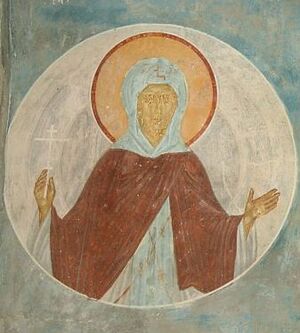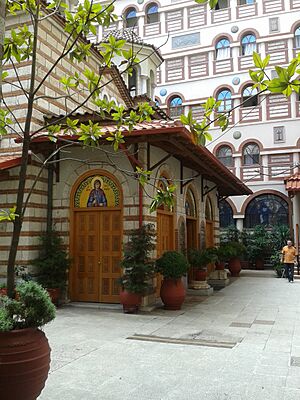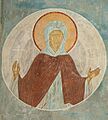Theodora of Thessaloniki facts for kids
Quick facts for kids VenerableTheodora of Thessalonica |
|
|---|---|

Theodora of Thessalonica in a fresco by Dionisius in the Ferapontov Monastery, 1502
|
|
| Born | 812 Aegina, Theme of Hellas, Byzantine Empire |
| Died | 29 August 892 Thessalonica, Theme of Thessalonica, Byzantine Empire |
| Venerated in | Eastern Orthodox Church |
| Major shrine | Thessalonike |
| Feast | 29 August |
Theodora of Thessalonica (Greek: Θεοδώρα Θεσσαλονίκης; 812–892) was a nun and a saint from Aegina, a Greek island. Her life story is one of the longest ever written about a holy woman in the Byzantine Empire. The Eastern Orthodox Church celebrates her special day, called a feast day, on August 29.
Contents
Her Early Life and Family
We know about Theodora's life from a writer named Gregory the Presbyter. Theodora was born in Aegina. Her father was a high-ranking priest who later became a monk. Her brother was a deacon, and her sister was a nun.
When she was seven, Theodora learned to read and studied parts of the Psalms. She was then promised in marriage to a noble man from Aegina.
Her early life was greatly affected by attacks from Arab groups in the 800s. These attacks caused a lot of damage to the coastal areas of the Aegean Sea. After her brother was killed in one of these attacks, Theodora moved with her husband and father to Thessaloniki. This probably happened around the year 826. They had many relatives in Thessaloniki, including aunts and an uncle who were involved in church life.
Life as a Nun
Theodora had three children. After two of her children passed away, she promised to dedicate her third child to a religious life. This daughter, Theophiste, had her hair cut short as a sign of becoming a nun. She joined the convent (a place where nuns live) of her aunt Aikaterina when she was six.
After her husband died in 837, Theodora gave her belongings to the poor and to the convent of St. Stephen the Protomartyr. She then joined this convent herself. She also had her daughter Theophiste move to the same convent.
Mother and daughter worked together for fifteen years. After that, Theophiste became the leader of the convent. Both Theodora and Theophiste lived in the monastery for twenty-four years. Theodora was not known for performing miracles during her lifetime. She also wasn't famous for extreme acts of self-discipline. However, she was praised for being obedient, working hard, and being humble.
Her Death and Miracles
Theodora passed away on August 29, 892. Some time after her death, people decided to move her body from the shared tomb of the nuns to her own special stone coffin.
Gregory, her biographer, described this event. A group of priests and religious people arrived at the tomb around midnight. But, by a miracle, they could not move the heavy tombstone. Only after they prayed were they able to open the tomb. They then placed her remains in a sarcophagus. From that moment on, a sweet-smelling, miraculous oil flowed from the coffin. Gregory also described several other miracles that happened after Theodora's death, including the healing of his own sister.
Her Lasting Impact
Most of what we know about Theodora's life comes from her biography. This long story was written not long after she died. It is the longest biography ever written about a holy woman in the Byzantine Empire.
The biography also includes a short story about Anthony the Confessor. He was an archbishop of Thessaloniki and Theodora's uncle. The story also contains a speech he gave against Byzantine Iconoclasm, which was a time when people argued about using religious images.
Later, during the time of the Palaiologan dynasty, a church official named John Staurakos wrote a praise for St. Demetrios and St. Theodora. It seems that these writings were for personal devotion and not for everyone to see. This suggests that many hymns and religious writings by women might have existed, but few are known today.
A painting of Theodora was made after her death. It showed her as young and beautiful. This might have been to show how people remembered her before she became a nun at age 25. It could also have been to highlight her purity, as beauty was sometimes linked to modesty and religious devotion. It might also show the sacrifice of her earthly life. Or, it could simply mean that people preferred to honor young and beautiful images.
Her worship continued even when the Turks ruled the area. It still continues today in the modern church of St. Theodora. This church is now part of a monastery for men. In August 2010, archaeologists in Thessaloniki found a tomb they believe belongs to Theodora. This is because a large church dedicated to Theodora had been found next to the tomb earlier.
Although her feast day was originally on August 29, it was moved to August 3. This was because August 29 was also the day for celebrating the beheading of John the Baptist.
Images for kids




